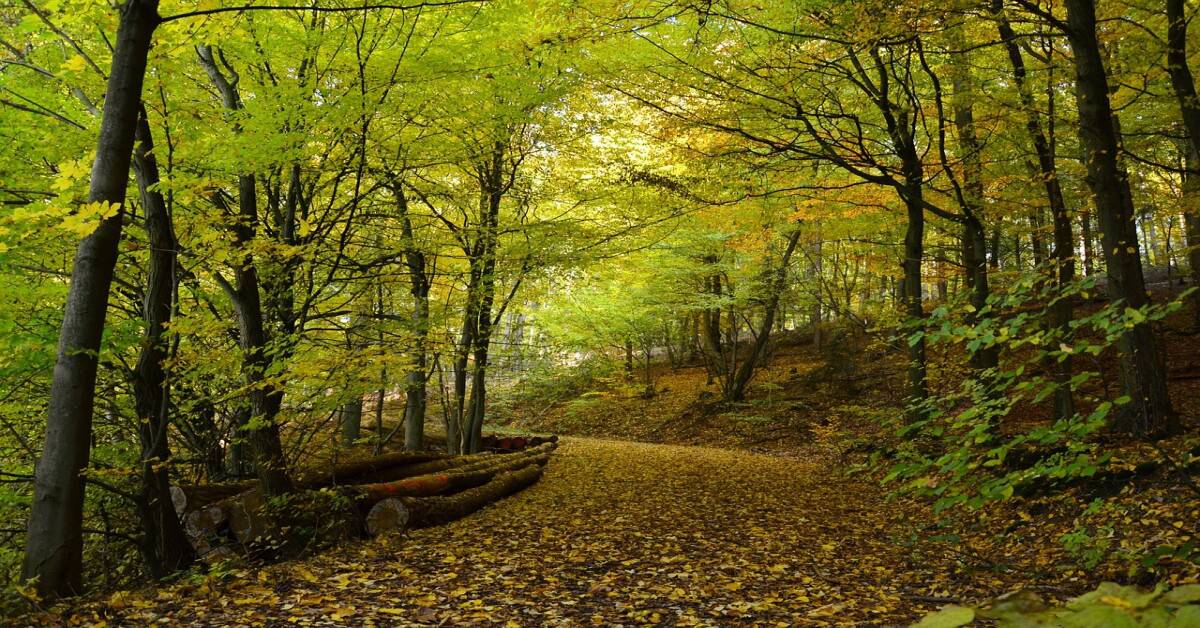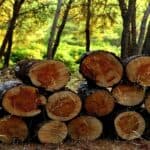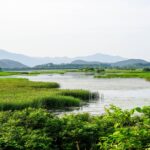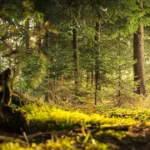Dry deciduous forests are unique ecosystems with distinct climates and vegetation. They are found in areas with seasonal rainfall and long dry spells, creating an environment where plants and animals must adapt to survive.
During the dry season, trees shed their leaves to conserve water, giving these forests a bare, almost ghostly look. However, they burst into life as the rains return, creating a lush, green landscape.
Dry deciduous forests include hardy trees like teak, acacia, and bamboo, which can withstand seasonal changes. These forests provide shelter and food for various animals, from herbivores like deer to predators like leopards.
Besides supporting biodiversity, dry deciduous forests play a vital role in soil conservation and carbon storage, making them essential for both nature and people.
Deciduous Forest
Dry deciduous forests are unique ecosystems found in regions with distinct wet and dry seasons. During the dry season, most trees in these forests shed their leaves to conserve water. This adaptation helps them survive in areas where rainfall is limited for part of the year.
These forests thrive in tropical and subtropical climates, such as in parts of India, Africa, and South America. For example, in India, dry deciduous forests are common in states like Madhya Pradesh and Karnataka.
The vegetation in dry deciduous forests includes hardy trees like teak, sal, and acacia, which are well-suited to drier conditions. These trees have deep roots that help them access groundwater and withstand prolonged dry periods.
Besides trees, the forests are also home to various shrubs and grasses that play a vital role in the ecosystem. Furthermore, dry deciduous forests support diverse wildlife, from herbivores like deer and elephants to predators such as tigers and leopards.
The seasonal changes in these forests impact the entire ecosystem. When the trees shed leaves, the forest floor becomes rich in nutrients, supporting a variety of plant and animal life.
Preserving dry deciduous forests is essential, as they not only provide valuable resources but also protect soil, store carbon, and support biodiversity.
Climate of Dry Deciduous Forests
Dry deciduous forests are typically found in regions with a pronounced dry season and moderate to low rainfall. In India, these forests cover parts of the states of Madhya Pradesh, Maharashtra, and Karnataka, where they experience an average annual rainfall of about 70 to 150 cm.
Globally, they’re also present in areas of Africa, Southeast Asia, and Central America. The climate in these regions is marked by hot, dry months and a short, intense wet season.
Temperatures can vary widely, with summer temperatures often reaching over 40°C, while winters are cooler and mild.
This pattern of distinct wet and dry seasons influences the ecosystem. During the dry months, water becomes scarce, forcing plants and animals to adapt for survival.
Trees shed their leaves to reduce water loss through transpiration. When the rainy season begins, these forests transform, as plants quickly grow back their leaves and many animals emerge from hiding.
This cycle not only shapes the forest’s appearance but also affects the behavior and survival strategies of the species that inhabit it.
Vegetation in Dry Deciduous Forests
Dry deciduous forests host a variety of plant species that are well-adapted to their seasonal climate. Common trees in these forests include teak, sal, and sandalwood, each of which can withstand long periods without water.
For example, teak trees have deep roots that allow them to access underground water, while sal trees have thick bark to prevent moisture loss. Another key plant, the acacia, has small leaves to reduce water loss, and the Indian gooseberry tree stores water in its trunk.
In the dry season, many trees shed their leaves to conserve moisture, giving the forest a bare appearance. This adaptation not only helps trees survive but also reduces competition for water resources.
When the rains return, the forest rapidly becomes lush and green again. This cyclical transformation supports a diverse range of life, providing food and shelter for various animal species.
Wildlife in Dry Deciduous Forests
The dry deciduous forests are home to a diverse range of animals that have adapted to the seasonal climate. Herbivores like spotted deer and sambar deer thrive here, feeding on the abundant grass and foliage during the rainy season.
The Indian bison, or gaur, is another herbivore that can survive on sparse vegetation during the dry months. Carnivores, such as the Bengal tiger and leopard, also inhabit these forests, relying on stealth and camouflage to hunt.
Besides these larger animals, the forest also supports a variety of smaller species. For example, langurs and macaques, which are types of primates, are commonly found in these areas, feeding on fruits, leaves, and insects.
Additionally, dry deciduous forests provide a habitat for various birds, reptiles, and insects that contribute to the ecosystem’s balance. Each species has developed unique survival strategies, making this ecosystem vibrant and resilient.
Also Read: Economic and Environmental Value of Forest Resources
Dry Deciduous Forest vs. Tropical Deciduous Forest in India
In India, both dry and tropical deciduous forests are essential to biodiversity but differ in climate and vegetation. Tropical deciduous forests, also known as monsoon forests, are found in areas with higher rainfall, like parts of the Western Ghats, the foothills of the Himalayas, and parts of the northeastern states.
These forests receive about 150 to 200 cm of rainfall annually, which is more than dry deciduous forests. This greater rainfall supports lush, dense vegetation, including tall trees and thick undergrowth.
In contrast, dry deciduous forests experience lower rainfall and have a longer dry season, leading to sparser vegetation. While both forest types shed leaves in the dry season, tropical deciduous forests have a shorter period of leaf loss and regenerate more quickly with the onset of rain.
Typical vegetation in tropical deciduous forests includes species like teak, bamboo, and rosewood, while dry deciduous forests have more drought-resistant species like acacia and sal.
Regions in India with tropical deciduous forests include parts of Assam, Odisha, and the Terai region of Uttarakhand. These forests are rich in wildlife and serve as critical habitats for species like elephants, tigers, and leopards.
Understanding the differences between these forest types highlights the variety within India’s ecosystems and the unique adaptations each environment supports.
Economic and Environmental Value of Dry Deciduous Forests
Dry deciduous forests hold significant economic and environmental value. Economically, these forests are essential sources of timber, which supports local industries and provides income for communities.
Teak and sal found abundantly in these forests, are especially valuable in the timber market due to their durability. Besides timber, these forests provide other forest products like bamboo, honey, and medicinal plants, which are crucial for local livelihoods and traditional medicine.
Many rural communities rely on these natural resources for food, fuel, and other daily needs, making dry deciduous forests vital for economic sustenance.
Environmentally, dry deciduous forests play an essential role in supporting biodiversity. These forests provide habitat for various species, including deer, leopards, and numerous bird species.
Furthermore, they help prevent soil erosion by holding the soil together with their root systems, reducing the risk of land degradation. These forests also contribute to carbon sequestration, capturing carbon dioxide from the atmosphere and mitigating climate change.
However, for these benefits to be sustained, it is crucial to manage the resources sustainably. Overexploitation of timber or other resources can harm the ecosystem, reducing its capacity to support biodiversity and contribute to climate regulation.
Therefore, balanced management practices are necessary to maintain both the economic and environmental value of these forests.
Threats to Dry Deciduous Forests
Dry deciduous forests face several serious threats, with deforestation being one of the most critical. Large sections of these forests are cleared for agriculture, urban expansion, and logging, reducing habitat for wildlife.
Climate change also poses a significant risk by altering rainfall patterns and increasing the frequency of droughts. This shift can lead to changes in vegetation, affecting the entire ecosystem.
Habitat fragmentation, caused by roads and infrastructure, disrupts animal movement, limiting their access to food and breeding areas.
These threats impact the vegetation, making it harder for certain plant species to thrive. The loss of trees and plants, in turn, affects wildlife that depends on them for food and shelter.
As the forest becomes more fragmented and degraded, the overall ecosystem loses its balance, affecting both biodiversity and natural processes. Protecting these forests is essential to preserve their unique flora and fauna and to maintain ecological stability.
Conservation Efforts for Dry Deciduous Forests
Efforts to conserve dry deciduous forests are underway through various initiatives, policies, and community actions. Governments in countries like India have implemented policies aimed at reducing deforestation and protecting these ecosystems.
For example, certain regions have been designated as protected areas, limiting human activity to safeguard wildlife habitats. Additionally, reforestation programs focus on restoring degraded areas by planting native tree species that support the local ecosystem.
Community involvement is also essential in conservation efforts. Many local organizations work with residents to promote sustainable practices and reduce dependence on forest resources. For instance, eco-tourism initiatives allow communities to earn income while preserving the forest environment.
Educational programs raise awareness about the importance of dry deciduous forests, encouraging people to participate in conservation efforts. By combining policies, reforestation, and community involvement, these initiatives aim to protect and restore dry deciduous forests for future generations.
Conclusion
Dry deciduous forests are essential for both economic and environmental stability. They provide valuable resources like timber and medicinal plants, which support local economies.
Besides their economic role, these forests are crucial for maintaining biodiversity, reducing soil erosion, and storing carbon, which helps combat climate change. The unique balance of dry deciduous forests’ climate and vegetation makes them resilient yet vulnerable to threats like deforestation and climate change.
Therefore, ongoing conservation efforts and sustainable management practices are vital to protect these ecosystems. Increasing awareness and encouraging involvement in forest conservation can help secure the future of these forests.
Protecting dry deciduous forests is not just about preserving nature but also about sustaining resources for future generations.






